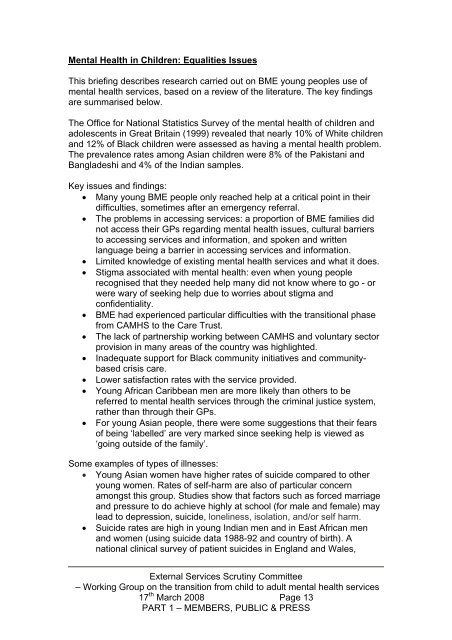Report - London Borough of Hillingdon
Report - London Borough of Hillingdon
Report - London Borough of Hillingdon
Create successful ePaper yourself
Turn your PDF publications into a flip-book with our unique Google optimized e-Paper software.
Mental Health in Children: Equalities Issues<br />
This briefing describes research carried out on BME young peoples use <strong>of</strong><br />
mental health services, based on a review <strong>of</strong> the literature. The key findings<br />
are summarised below.<br />
The Office for National Statistics Survey <strong>of</strong> the mental health <strong>of</strong> children and<br />
adolescents in Great Britain (1999) revealed that nearly 10% <strong>of</strong> White children<br />
and 12% <strong>of</strong> Black children were assessed as having a mental health problem.<br />
The prevalence rates among Asian children were 8% <strong>of</strong> the Pakistani and<br />
Bangladeshi and 4% <strong>of</strong> the Indian samples.<br />
Key issues and findings:<br />
• Many young BME people only reached help at a critical point in their<br />
difficulties, sometimes after an emergency referral.<br />
• The problems in accessing services: a proportion <strong>of</strong> BME families did<br />
not access their GPs regarding mental health issues, cultural barriers<br />
to accessing services and information, and spoken and written<br />
language being a barrier in accessing services and information.<br />
• Limited knowledge <strong>of</strong> existing mental health services and what it does.<br />
• Stigma associated with mental health: even when young people<br />
recognised that they needed help many did not know where to go - or<br />
were wary <strong>of</strong> seeking help due to worries about stigma and<br />
confidentiality.<br />
• BME had experienced particular difficulties with the transitional phase<br />
from CAMHS to the Care Trust.<br />
• The lack <strong>of</strong> partnership working between CAMHS and voluntary sector<br />
provision in many areas <strong>of</strong> the country was highlighted.<br />
• Inadequate support for Black community initiatives and communitybased<br />
crisis care.<br />
• Lower satisfaction rates with the service provided.<br />
• Young African Caribbean men are more likely than others to be<br />
referred to mental health services through the criminal justice system,<br />
rather than through their GPs.<br />
• For young Asian people, there were some suggestions that their fears<br />
<strong>of</strong> being ‘labelled’ are very marked since seeking help is viewed as<br />
‘going outside <strong>of</strong> the family’.<br />
Some examples <strong>of</strong> types <strong>of</strong> illnesses:<br />
• Young Asian women have higher rates <strong>of</strong> suicide compared to other<br />
young women. Rates <strong>of</strong> self-harm are also <strong>of</strong> particular concern<br />
amongst this group. Studies show that factors such as forced marriage<br />
and pressure to do achieve highly at school (for male and female) may<br />
lead to depression, suicide, loneliness, isolation, and/or self harm.<br />
• Suicide rates are high in young Indian men and in East African men<br />
and women (using suicide data 1988-92 and country <strong>of</strong> birth). A<br />
national clinical survey <strong>of</strong> patient suicides in England and Wales,<br />
External Services Scrutiny Committee<br />
– Working Group on the transition from child to adult mental health services<br />
17 th March 2008 Page 13<br />
PART 1 – MEMBERS, PUBLIC & PRESS
















